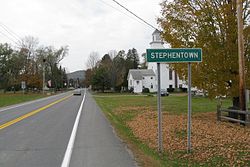Demographics
Historical population| Census | Pop. | Note | %± |
|---|
| 1820 | 2,592 | | — |
|---|
| 1830 | 2,716 | | 4.8% |
|---|
| 1840 | 2,753 | | 1.4% |
|---|
| 1850 | 2,622 | | −4.8% |
|---|
| 1860 | 2,311 | | −11.9% |
|---|
| 1870 | 2,133 | | −7.7% |
|---|
| 1880 | 1,986 | | −6.9% |
|---|
| 1890 | 1,764 | | −11.2% |
|---|
| 1900 | 1,545 | | −12.4% |
|---|
| 1910 | 1,289 | | −16.6% |
|---|
| 1920 | 1,109 | | −14.0% |
|---|
| 1930 | 1,093 | | −1.4% |
|---|
| 1940 | 1,181 | | 8.1% |
|---|
| 1950 | 1,295 | | 9.7% |
|---|
| 1960 | 1,361 | | 5.1% |
|---|
| 1970 | 1,731 | | 27.2% |
|---|
| 1980 | 2,031 | | 17.3% |
|---|
| 1990 | 2,521 | | 24.1% |
|---|
| 2000 | 2,873 | | 14.0% |
|---|
| 2010 | 2,903 | | 1.0% |
|---|
| 2020 | 2,791 | | −3.9% |
|---|
|
As of the census [6] of 2010, there were 2,903 people, 1,141 households, and 838 families residing in the town. The population density was 49.8 inhabitants per square mile (19.2/km2). There were 1,339 housing units at an average density of 23.1 per square mile (8.9/km2). The racial makeup of the town was 96.7% White, 0.31% African American, 0.21% Native American, 0.14% Asian, 0.07% Pacific Islander, and 0.77% from two or more races. Hispanic or Latino of any race were 3.11% of the population.
There were 1,141 households, out of which 35.5% had children under the age of 18 living with them, 59.5% were married couples living together, 8.2% had a female householder with no husband present, and 27.2% were non-families. 21.0% of all households were made up of individuals, and 7.2% had someone living alone who was 65 years of age or older. The average household size was 2.54 and the average family size was 2.94.
In the town, the population was spread out, with 25.7% under the age of 18, 6.8% from 18 to 24, 31.1% from 25 to 44, 26.1% from 45 to 64, and 10.4% who were 65 years of age or older. The median age was 38 years. For every 100 females, there were 96.0 males. For every 100 females age 18 and over, there were 99.3 males.
The median income for a household in the town was $59,769, and the median income for a family was $61,347. Males had a median income of $31,535 versus $26,611 for females. The per capita income for the town was $25,352. About 5.7% of families and 6.6% of the population were below the poverty line, including 9.0% of those under age 18 and 7.0% of those age 65 or over.
Electric power facilities
Stephentown Spindle
Pursuant to Section 68 of the Public Service Law, Stephentown Regulating Services LLC (SRS) (now operating as Stephentown Spindle LLC (SS)) was granted a Certificate of Public Convenience and Necessity for a 20-megawatt (MW) flywheel-based energy storage facility in 2009. It went in-service in 2010. There are 200 flywheels set within 20 pods on 5-acres that spin at high rates of speed (8,000 rpm to 16,000 rpm) storing energy as rotational energy. Each flywheel weighs 5 tons. The flywheels are energized by and discharge their energy into the New York State transmission system. [8] [9] [10] [11]
The project was initially financed in 2010 with a $43 million loan from the federal Department of Energy, however, this amount was reduced to $25 million in 2012 when SS acquired the SRS assets. The company does not sell energy into the NYISO's electric wholesale market or capacity market, however, it does receive revenue from the ancillary services market for providing frequency regulation service. The stakeholder-driven policy at the NYISO excludes the facility from providing power into the NYISO's wholesale electric and capacity markets because it does not meet minimum criteria - a minimum of 5 minutes or 1 hour - for sustained energy delivery. The regulation service market in the NYISO provides revenue via two streams, a main regulation capacity price ($/MWh over a five-minute interval in the real-time market) based on a day-ahead and real-time market price, and a movement (performance) award ($/MW). For example, if the facility were able to provide its 20 MW output for 12 hours of the day at an average regulation price of $11 per MWh the facility would receive $963,600 a year. Revenue received from the performance fee, which averaged about $2.30 per MW in Q2 of 2018, is a much smaller proportion of annual revenue. [12] [13] [14] [15] [16]
It is the first commercial flywheel project in the United States to provide frequency regulation service. The only other comparable utility-scale energy storage facilities in New York are NYPA's 1,100 MW pumped storage facility at Blenheim-Gilboa and NYPA's 240 MW Lewiston pumped storage facility at Niagara Falls. For a power comparison, the capital region's peak summer demand was 2,032 MW in 2017. [16]
This page is based on this
Wikipedia article Text is available under the
CC BY-SA 4.0 license; additional terms may apply.
Images, videos and audio are available under their respective licenses.



